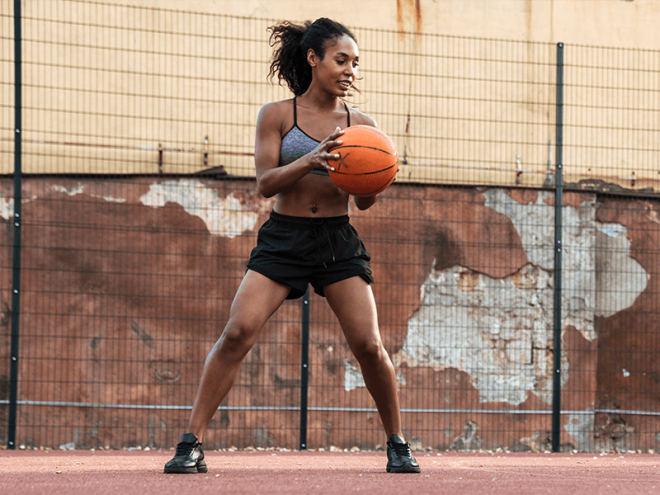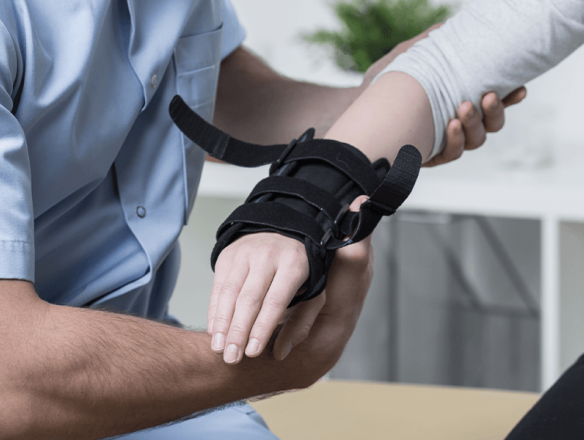
News & Insights
5 ACL Injury Prevention Exercises
Oct 12, 2021
A sprain or tear of the ACL is one of the most common athletic injuries. But before one can consider how to prevent ACL tears and sprains, we must understand what the ACL is. The anterior cruciate ligament, or ACL, is a thick, strong ligament located behind the kneecap. It connects the femur (thigh) to the tibia (shinbone or main bone of the lower leg) and prevents the tibia from sliding forward ahead of the femur.
The ACL is often injured during athletic activities involving sudden stops, changes in direction, or jumping and landing. A “popping” sound or feeling is often felt in the knee when the ACL is injured. However, as with all things involving the body, prevention is always better than even the best treatment. And fortunately, there are well-studied ACL injury prevention exercises that help to prevent these injuries.
ACL Strengthening
ACL injury prevention exercises include strengthening leg muscles, including those that connect the femur to the tibia. The muscles are necessary, of course, to allow the thigh and lower leg to move when walking, running, jumping, etc. By strengthening the muscles that support the same joint as the ACL and other joints close to the knee, injury to the ACL becomes less likely. Some of the best exercises that strengthen the muscles of the legs include:
● Walking Lunges - Lunges strengthen the thigh muscles (quadriceps).
● Hamstring Leans - These strengthen the muscles in the back of the thigh.
● Single Toe Raises - You use your toes (not one toe) while the other leg is raised by bending the knee. These exercises strengthen the muscles in the calf (back of the lower leg) and improve overall balance.
● Squats - Whether traditional or wall squat, these exercises strengthen the quadriceps and hamstring muscles while improving balance.
● Split Jumps - Several studies have shown these to be one of the best ACL injury prevention exercises. This can be a difficult exercise to perform correctly, but it is important to gradually increase the duration and intensity of split jumps to ensure the best results. They should only be done for as long as the strength and stamina are available to perform them perfectly.
These five exercises will increase the strength of the muscles in the thigh and lower leg and are some of the most recommended injury prevention exercises. They cannot be done just one time, the day before an activity. They need to be done regularly to ensure the muscles are strengthened, which assists with ACL strengthening.
ACL Prevention Band Exercises
Resistance bands offer many benefits when doing exercises, especially ACL injury prevention exercises. Resistance bands are lightweight, portable, inexpensive loops that provide resistance during exercise. They are often better than using weights because they provide no momentum. The momentum of weights can result in a seemingly more intense workout due to the motion of the weights, not from more muscle activity.
There are many exercises that can be performed using a resistance band. Some can only be performed using a resistance band including the Hip Bridge and Clam Shell. These two exercises are especially important exercises for females to do. They help to correct one of the major reasons females are much more likely to suffer ACL injuries than males. (See the next section on ACL Prevention for Females).
It is also important to exercise the core. Essentially, the core includes all of the body’s muscles besides the arms and legs. Exercises to strengthen the core are very important ACL injury prevention exercises and should not be overlooked. Resistance bands can be helpful in core strengthening with exercises such as:
● Standing Knee Tuck
● Hollow Body Roll
● Bicycle Crunch
● Side Plank
● Single-Leg T Row
● Spiderman Push-up
● T-Rotation Lunge
● Unilateral Squat
Of course, it isn’t necessary to do every exercise to strengthen the core. However, the more exercises one can do, the less likely one is to get bored doing the same thing repeatedly. Exercise variety can make it less likely that people will give up on their ACL injury prevention exercises.
ACL Prevention for Females
Studies have shown that females are up to eight times more likely to suffer an ACL injury than males. In fact, they are one of the most common types of injuries in young female athletes occurring at least 38,000 times every year or more than one ACL injury every 15 minutes.
While there is little agreement on the precise reasons for the dramatically increased incidence in females, factors including anatomic, hormonal, and biomechanical differences are likely involved. In addition, with about 80% of ACL injuries in females occurring without any contact from another person, prevention becomes even more critical for the younger female athlete.
Two major theories have become prominent in explaining the gender differences in the frequency of ACL injuries. The first involves landing position. Females tend to land after any jump (e.g., basketball, long jump, cheerleading) with their legs in straighter, knees locked position while males are more likely to have the knee bent cushioning the landing force. The second involves the angle of the femur (more inward in females) and of the lower leg (more outward), creating a knock-knee position when females jump, land, or twist. This position puts more stress on the knee joint, and in turn, the ACL.
So, with all of that said, ACL injury prevention exercises are especially important for female athletes. In addition to devoting considerable time to the exercises already listed, other factors that can help reduce the chances of an ACL injury include:
● Stretching fully and completely before any exercise or athletic activity.
● Practicing proper landing skills. These should include:
● Landing with the knees bent but the legs (thighs, knees, and lower legs) kept in a straight line.
● Landing on the balls of the feet instead of the entire foot or heel.
● Maintaining a proper body posture throughout the landing.
● Ensuring both feet land simultaneously. (No one-footed landings.)
● Practicing proper pivoting. Women tend to remain more erect when turning, which can stress the ACL. One exercise is practicing pivoting in a slightly crouched position with the hips and knees slightly bent.
● Increasing agility by practicing running, stopping, pivoting, and running in another direction while maintaining the proper body position.
Final Thoughts
As long as ACL injuries are common injuries, ACL injury prevention exercises will remain the primary means of preventing these painful and debilitating injuries. Ensuring you know how to practice injury prevention exercises is important correctly. Injuries can and do occur from improper and too much exercise. Knowledgeable and experienced professionals will answer your questions.
To find the best specialists, including orthopedic and sports medicine physicians and physiatrists who are experts at preventing and treating ACL injuries, contact one of the knee specialists at The Orthopedic Institute of New Jersey. It has locations throughout New Jersey.
For a consultation about prevention exercises, athletic injuries, or any orthopedic or sports medicine issue, contact an OINJ doctor near you.
Latest News
What is Mommy Thumb? | Causes of De Quervain's Tenosynovitis
What is mommy thumb? What causes it, how does it feel, and how do you treat it? Here’s what you should know about de Quervain’s tenosynovitis.
Read moreHow to Prevent Plantar Fasciitis: Tips for Foot Health and Injury Avoidance
At least 10% of the general population needs an answer to the question of how to prevent plantar fasciitis. Read our articles to find some answers.
Read moreWrist Fracture Treatment Options: Exploring Surgical and Non-Surgical Methods
Wrist fracture treatment depends on the type and the severity of fracture. Here’s when you need surgery and when a conservative treatment will be enough!
Read more





















